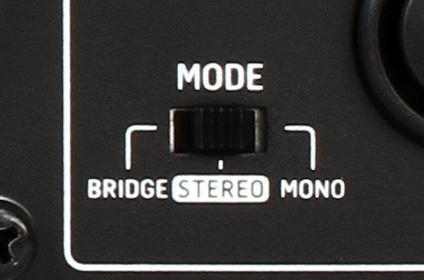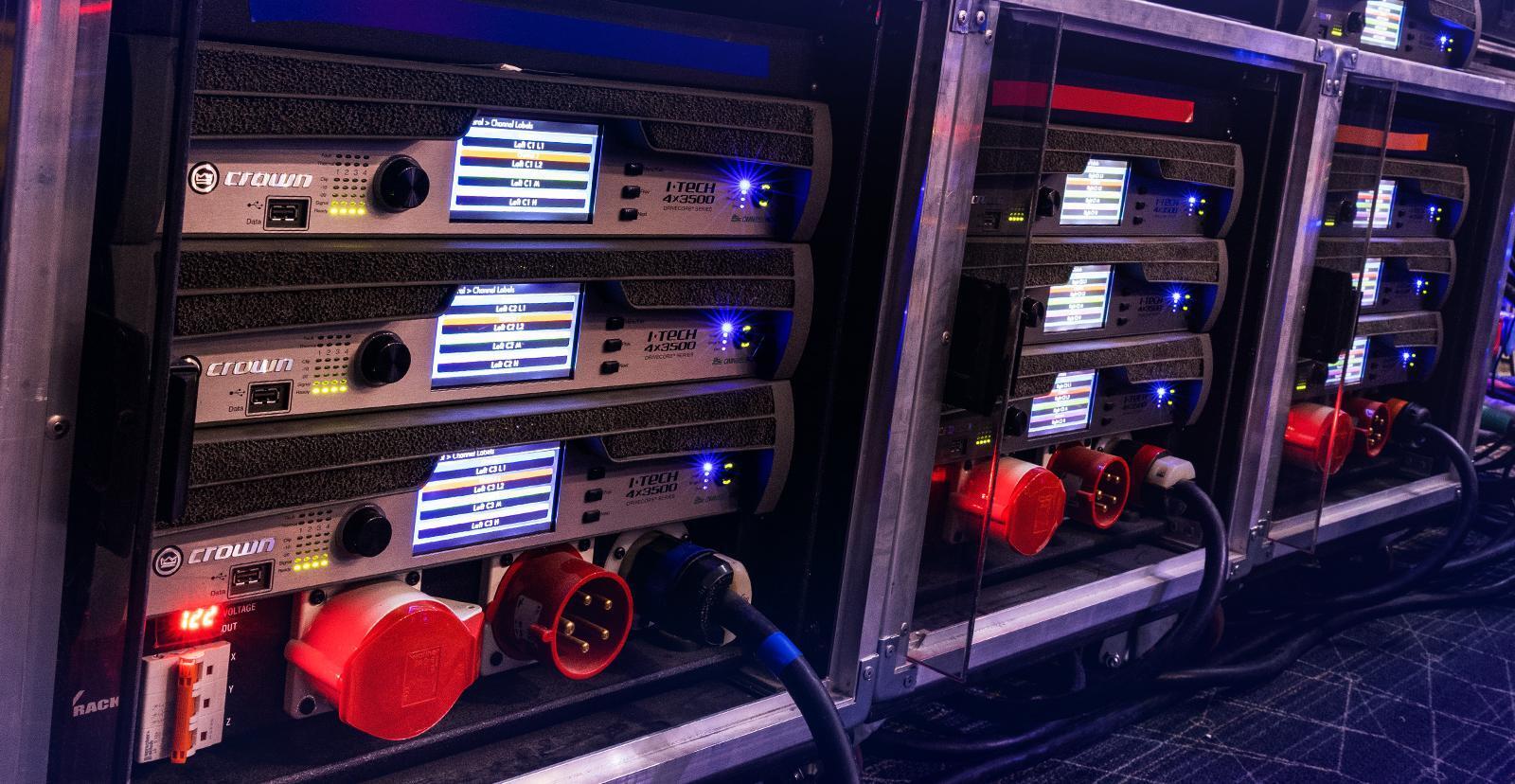You’ll find one or more power amplifiers at the heart of any live sound rig. So, what’s a power amplifier? Why do you need one? What are watts, ohms, and impedance? Which power amps are compatible with your speakers? Sweetwater’s Power Amp Buying Guide will answer these and many other common questions.
What’s a Power Amplifier?
A power amplifier is a device that sits between a sound source and a passive loudspeaker. Its job is to take a line-level signal and make it loud enough to fill a room or a venue with sound. Power amps can feature one, two, or more channels. For example, a mono power amp would have one channel, and a stereo power amp would have two channels. While designs vary, a standard feature on most power amplifiers is a power switch, which engages the device, and a volume control, which determines the device’s output level. If you want to increase the volume of a sound source so you can push it through a speaker (or multiple speakers), then you’ll need a power amplifier to get the job done.
How Many Watts Do I Need?
Power amplifiers are rated in watts, which is a unit of power. To determine how many watts you’ll need for your given setup, you should know how much power your speaker(s) can handle. This is known as power handling. When you’re matching a power amp to a PA speaker setup, a good rule is to pick an amplifier that can deliver power output equal to twice the speaker’s continuous rating. So, a speaker with a nominal impedance of 8 ohms and a continuous power rating of 350 watts will require an amplifier that can produce 700 watts into an 8-ohm load (we’ll delve into impedance in the next section). The amplifier should be rated at 700 watts per channel into 8 ohms for a stereo pair of speakers. A professional-level loudspeaker can handle transient peaks above its power rating if they occur.
Ohms and Impedance . . . Huh?
An ohm is a measure of electrical resistance. Audio amplifiers are designed to work with 4-, 8-, or 16-ohm speaker loads, and you will achieve optimum system performance if the total ohm load of the loudspeakers is precisely correct for the amplifier. If the total loudspeaker impedance is too high, then that will reduce the power delivered to the loudspeakers. If the total loudspeaker impedance is too low, then the power delivered to the loudspeakers will be higher, which can overload your speakers and may damage the amplifier. You can connect any number of speakers to one amplifier provided they are interconnected so that the cumulative resistance doesn’t fall below the specified output impedance of the amp.
To connect multiple speakers to a single amplifier, you will need to understand the difference between wiring speakers in parallel or in series.
Parallel
The following general rule will help you match the impedance of PA speakers to power amplifiers for optimized performance (avoiding overloads and other issues). Don’t worry; it’s an easy formula to use and remember.
To keep the impedance equation as simple as possible, most people put enclosures of the same impedance in a parallel circuit. If you use enclosures with the same impedance, then it’s as simple as dividing that impedance by the number of speakers.
Impedance rating of your speaker cabinets
Number of speaker cabinets
For example, if you have four speaker cabinets rated at 16 ohms, then the equation is 16 ohms divided by 4 cabinets, resulting in an overall rating of 4 ohms. Alternately, connecting two 8-ohm speakers (or cabinets) in parallel translates into 8 ÷ 2 = 4 ohms.
Here is a quick reference list of some commonly used parallel loads. NOTE: Do not connect a load lower than the output impedance rating of your power amp.
- Two 16-ohm speakers = 8 ohms
- Two 8-ohm speakers = 4 ohms
- Two 4-ohm speakers = 2 ohms
- Three 16-ohm speakers = 5.33 ohms
- Three 8-ohm speakers = 2.67 ohms
- Three 4-ohm speakers = 1.3 ohms
- Four 16-ohm speakers = 4 ohms
- Four 8-ohm speakers = 2 ohms
- Four 4-ohm speakers = 1 ohm
Series
Alternatively, you can connect your speakers in series, and that math is even easier. Add up the impedance of all the cabinets together to find the cumulative load. Wiring two 8-ohm speakers in series results in a 16-ohm load (8 + 8 = 16). If you connect four 4-ohm speakers in series, then you’ll end up with a 16-ohm load (4 + 4 + 4 + 4 = 16).
What Is Headroom? Why Does It Matter?
Using an amp with extra headroom will help assure that only clean, undistorted power gets to your speakers. Headroom is the difference between the average operating level of an amplifier and the maximum level that the amp can deliver without unacceptable distortion. Music has wide variations in dynamic range; without enough headroom, you may frequently hear your gear clipping (distorting). Choosing an amp with adequate headroom is critical. The correct amp for your application will have sufficient power to reproduce transient peaks (which can easily be 10x the average level) cleanly. You should select a model with an output power rating equal to the speaker’s continuous power rating. Consult the amplifier manufacturer or owner’s manual to learn more.
For applications such as critical listening in a studio environment, an amp needs enough headroom to cleanly reproduce transient peaks. In these circumstances, use an amplifier that can deliver a minimum of 2x–4x the speaker’s continuous power rating.
If budget constraints or legacy equipment force you to use an amplifier with less power, then you should take extreme care to see that the amplifier is not driven into clipping. When pushed beyond its power limitations, an underpowered amplifier will go into clipping, and the resulting square waves can damage your speakers. It may surprise you to learn that low power can result in damage to your speaker or system.
Why Would I Want a Class D Amplifier?
You’ll often hear power amps described as Class A, AB, or D amplifiers. Some misinformed pro-audio “experts” have spread the notion that these lettered classifications are a measure of sound quality, but that’s not the case. Rather, these letters refer to different circuit designs. Historically, Class A and Class AB designs dominated the market. Unfortunately, their components make them large and heavy, and their inefficiency results in high power consumption and heat output. Over the past couple decades, Class D power amplifiers have taken over the live sound market due to their smaller size and reduced power consumption. A Class C amplifier can produce as much power as a Class A or Class AB amp but far more efficiently, maintaining sound quality sufficient for sound reinforcement while dramatically reducing the size and weight of your amplifier rack.
What’s Bridging? How Can It Benefit Me?
Bridging is a method of configuring a multichannel amplifier so that multiple channels are “ganged” or bridged to be used together to drive a single load. Bridging allows you to take a multichannel amp and create a larger single-channel amp to deliver more power. The result is more power to the speaker than is possible from either channel alone. For example, a stereo 100-watt-per-channel amp that is bridged may offer a resulting 300 watts. Many modern amps have a switch that enables mono bridging operation.

Typically, amplifiers operating in bridged mode can only do so with speakers that have twice the impedance of the minimum load rating on the amp. For example, an amp rated at 4 ohms to run in normal mode will generally require 8 ohms in bridged mode.
How Can a Limiter Protect My System?
Many power amplifiers feature a built-in limiter to maximize signal levels while safeguarding against distortion, preventing overload in a signal chain, setting a maximum volume level to protect users of in-ear monitors, protecting speakers and amplifiers from clipping, and so on. Any time you want to establish a maximum gain setting and prevent signals from exceeding it, a limiter is your tool of choice.
Helping You Find the Right Amplifier
Our pro-audio lineup consists of countless power amp models with vastly different specs and feature sets. If you’re unclear about all the available options, then call your Sweetwater Sales Engineer at (800) 222-4700; they can help you determine which power amplifier will best suit your needs.



